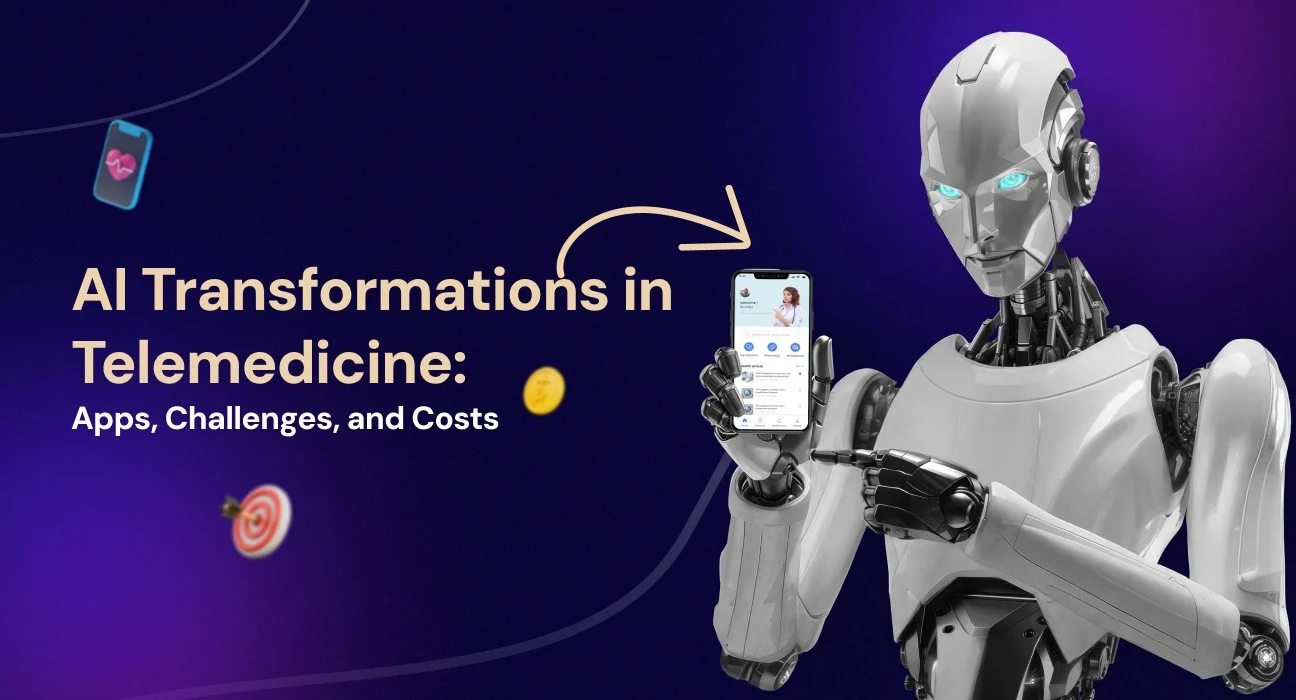

The landscape of healthcare has evolved significantly over the past few years. The reason has been innovations and changes in technology and recent developments caused by the COVID-19 pandemic.
In this period one notable evolution is the combination of Artificial Intelligence (AI) and telemedicine app development in the healthcare industry. It is completely changing how we provide patient care, turning diagnoses and treatments into something much quicker, more accurate, and accessible through physical barriers.
Here, we are going to understand every aspect related to AI in medicine to help you move ahead with complete clarity. Read on.
Telemedicine in Healthcare: Fuelled by AI
Source By: credenceresearch.com
Telemedicine in healthcare means the provision of a clinical service through distance on a digital platform that enables access to healthcare, transcending geographical distances altogether. The sector has exploded as the market of telemedicine in healthcare was estimated to grow from USD 141,135 million in 2024 to USD 523,000 million by 2032, with a compound annual growth rate (CAGR) exceeding 17.9% in some markets altogether. But the question is what has fueled the growth of telemedicine? The reasons are:
- Increased demand for remote consults.
- Government incentives.
- And the face of higher healthcare costs.
AI is now the biggest driver, with most of the healthcare organizations implementing AI into their day-to-day functions. In fact, after implementation, most of those institutions have noted a significant reduction in staff burnout after the implementation of AI solutions that enable both task completion and support patient care.
Most Popular AI-Powered Telemedicine Apps
Modern telemedicine software development harnesses various AI features to enhance traditional healthcare delivery. Some popular applications in this space include:
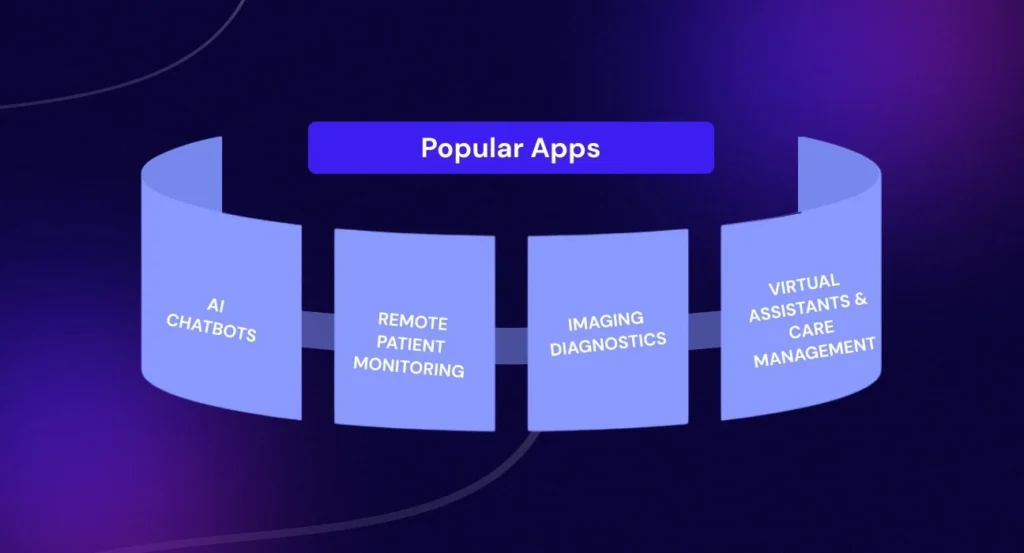
- AI Chatbots: Utilizing advanced natural language processing and machine learning capabilities, AI chatbots can guide patients, conduct symptom checks, and triage cases. Examples include Babylon Health, ADA Health, and HealthTap. These applications are used all over the world for medical advice and guiding users in dealing with the urgency of their health complaints.
- Remote Patient Monitoring: Remote patient monitoring devices and applications like Teladoc and Amwell allow ongoing monitoring of those who have chronic disease states and conditions using AI algorithms to identify abnormalities and alert the healthcare team when further interventions are warranted. These monitoring platforms connect to wearables, biosensors and smart devices that continuously collect patient data.
- Imaging Diagnostics: Imaging diagnostic solutions like Zebra Medical Vision and Aidoc use deep learning to detect abnormalities in X-ray, CT scans, and MRIs. AI solutions are more accurate, they’re faster than human experts and can accelerate the early diagnosis and treatment of critical illnesses.
- Virtual Assistants and Care Management: Virtual assistant and care management solutions like Your. MD and Sensely help patients with appointment scheduling, reminders, patient engagement, and answering questions. They are a way to enrich patient experience while decreasing the admin burden on clinics.
Every telemedicine application includes potential telehealth app development services tailored to different groups including patients, physicians, and laboratory technicians with potential capabilities to complete the visit digitally.
Challenges in AI-Driven Telemedicine
Although there is great potential for AI to impact positively on healthcare software development, there are some impediments to the successful integration of AI.
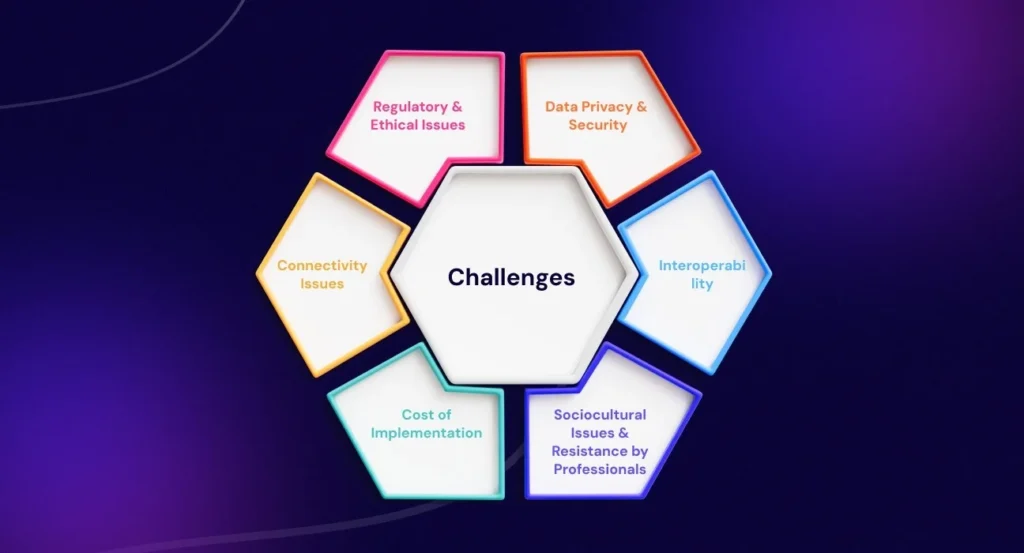
- Data Privacy and Security: It is critical for telemedicine software to protect the sensitive data of patients. In order to protect patients’ data, practice management software needs to comply with legislation, such as HIPAA and the GDPR, needs to provide end-to-end encryption, and receive regular audits in order to build and maintain trust.
- Interoperability: There is a lack of capacity currently for many telemedicine interfaces to plug into existing systems. Standardized API connections and FHIR Protocols can help, but not all institutions have standardized use of these protocols.
- Sociocultural Issues and Resistance by Professionals: Some healthcare providers are hesitant and do not trust the AI recommendations simply because they are unfamiliar with them. Training, and for clinicians, inclusion in AI development can create a foundation for more acceptance of AI as a valuable tool.
- Cost of Implementation: There are significant costs to develop and deploy new AI systems. Programmers and developers of the technology suggest customizable and scalable tools or cloud hosted infrastructure to lessen the cost, however, cost remains a serious concern for a small or mid-size clinic.
- Connectivity Issues: Providing real-time care and data delivery is complicated by unreliable internet connections in rural or remote areas. There are offline-first solutions being developed as well as AI models for low-bandwidth.
- Regulatory and Ethical Issues: There are ongoing regulatory and ethical questions related to AI decision making that relate to ensuring that AI decision making systems are transparent, and minimizing risk to patients by ensuring human oversight in decisions made on behalf of patients.
Telemedicine App Development: Features and Workflow
The development of your unforgettable telemedicine app requires careful planning, strong security, and consumer-friendly design. While the key features will differ, it is common for telemedicine apps to have the following features.
- A secure signup-login process
- Video call functionality for providers and patients
- Instant messaging
- Calendar integration for appointments
- Payment gateways
- Prescription access
More advanced custom software development projects will also include AI/chatbots, appointment scheduling, predictive analytics, and real-time health monitoring. When developing a custom telemedicine app, custom software development companies outline the process as follows:
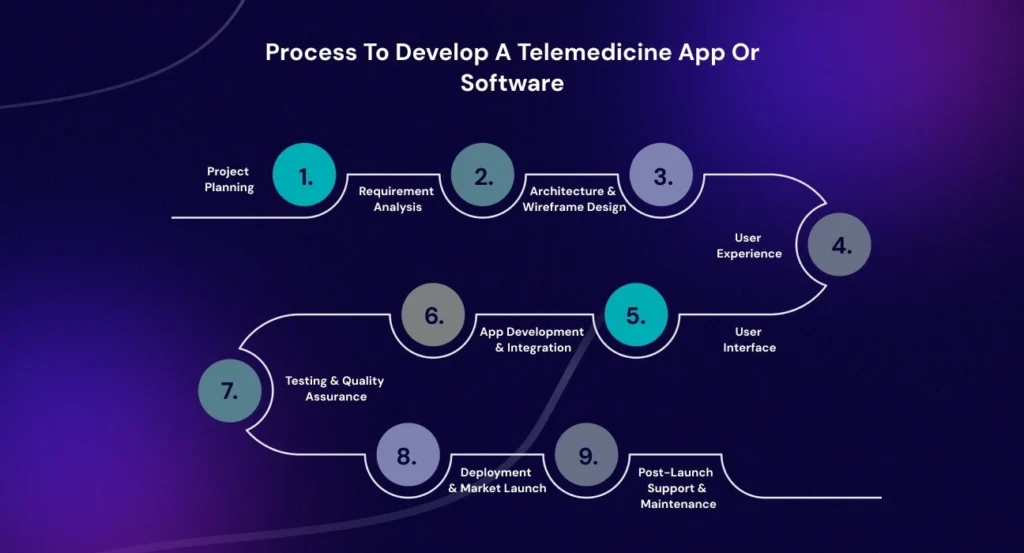
1. Project Planning and Requirement Analysis
The project planning and requirement analysis phase of a telemedicine or healthcare app development is your first step in the process, and where you and your team will spend a lot of time thoughtfully planning and analyzing your requirements. In this phase, there will be lots of discussion among your stakeholder team members to develop the project’s goals and list of core functionality, and they will assess stakeholders’ needs with laws that must be adhered to, such as HIPAA or GDPR, etc. It is also important to note who the intended audience is and who the users (patients, providers, and admins) are, and make a roadmap that will lead to a workflow for the development stages that will follow. This planning phase is key in setting the pedal to the metal for your telemedicine app development and making sure everyone understands the details about the project.
2. Architecture and Wireframe Design
Once the requirements have been agreed upon, the next phase involves determining the software architecture of the app and making wireframes. The architecture decisions dictate the secure and effective handling of patient data, video consultations, and messaging. The wireframes help visualize the flows of the user experience, identify main features and paths for users, and provide a reference point for developers and designers. This stage accomplishes a couple of important things, including technical feasibility and establishing a human-centered design for future points of development.
3. User Experience (UX) & User Interface (UI) Design
The UX/UI design stage designs the telemedicine app, visually and functionally. The UX designer maps out a smooth and natural patient and provider journey, optimizing for ease of navigation, appointment scheduling, and access to information. Then, the UI designers will transform the UX workflow into screens, colors, icons, and interactive design elements to enable the doctor-patient interactions. Using iterative feedback from stakeholders ensures that the design validates both the look and feel of the application, as well as supporting the appropriate real-world use cases.
4. App Development and Integration
With the designs finalized, development begins. The developers build the back-end infrastructure, implement data privacy and security, and build all the features like scheduling, messaging, and video calls. Oftentimes, this phase will include the integration of Electronic Health Record (EHR) systems, appointment management, and payment gateways. The development is a complex process, often employing Agile processes to enable incremental improvement and also to be opportunistic as changes arise in the needs required for telemedicine software development.
5. Testing and Quality Assurance
When the development phase is complete, good testing and quality assurance takes place. This will involve the team looking for buggy software as well as testing the features on a few devices. The team is going to continue testing a few variables, including the app that implements healthcare protocols and regulatory issues. Then the usability of the app will be analyzed from the patients’ and providers’ perspectives, to ensure something like a video call, a prescription or messaging is going to work.
6. Deployment and Market Launch
Once the app passes the quality assurance phase, the app is deployed to app stores (Google Play, Apple App Store) and/or healthcare provider servers. The deployment stage involves making sure the application is compliant with the platform requirements and publishing guidelines. Finally, post-launch, the team can help with onboarding, support for any user questions, and help the launch marketing campaign. It is extremely important to make sure the intended audience can benefit from the telemedicine app.
7. Post-Launch Support and Maintenance
The final stage of the telemedicine app development cycle involves support post-launch and regular maintenance going forward. The development team will be available to fix bugs, address user feedback, make improvements to functionality, and satisfy compliance as the regulations change. It will be helpful for the healthcare providers and developers to focus on post-launch support to ensure user needs are met and the long-term viability of the telemedicine app is realized. Ongoing efforts will help ensure the telemedicine app stays updated, secure, and effective in a rapidly changing digital healthcare community.
Read Also: How Much Cost to Build Healthcare Practice Management Software Like Cliniko?
Cost to Develop a Telemedicine App
The cost to develop a telemedicine app will depend on a variety of factors: complexity of the app, features you choose to implement, what platform (iOS, Android, or Web) to build for, regulatory needs, and whether or not you require integration with EHR or EMR systems.
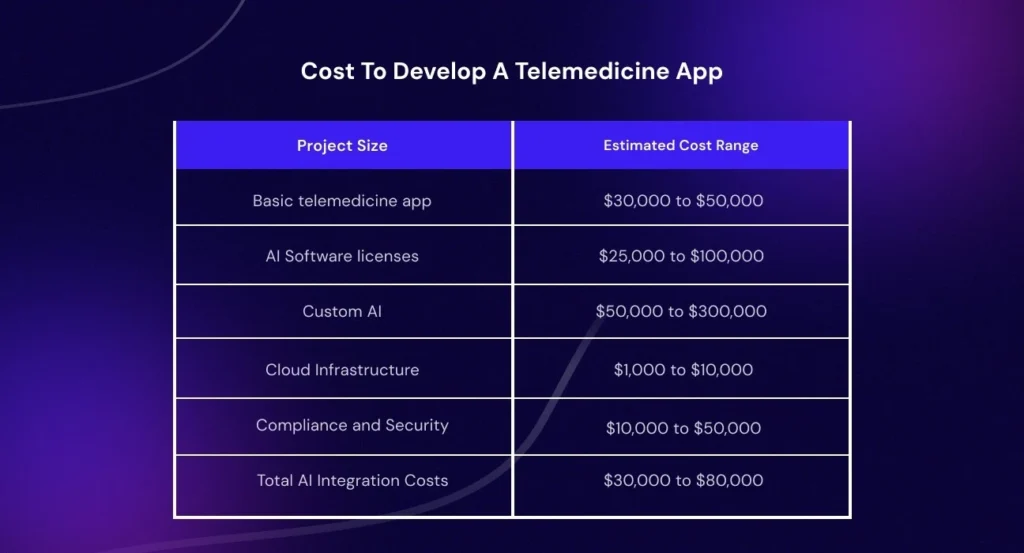
- Basic telemedicine app: The costs can range from $30,000 to $50,000 for one platform (Android, iOS, or Web) and minimal features; also, builds take around 4-6 months for a custom software dev company.
- AI Software licenses: $25,000 – $100,000 per year, using commercial AI platforms (chatbots, diagnostics, etc).
- Custom AI: To build customized solutions, integration, and training will likely cost $50,000 – $300,000 USD or higher to develop enterprise-grade telemedicine software.
- Cloud Infrastructure: AI services will run around $1,000 – $10,000 a month operating on AWS, Azure, or Google Cloud, depending on usage.
- Compliance and Security: Ongoing costs will include data protection measures and regulatory legal costs at an estimated $10,000 – $50,000/year.
- Total AI Integration Costs: Depending on your scale of project, AI integration costs can exceed $1 million for a full-scale hospital or pharma company project; however, SMEs may find an effective solution for $30,000 – $80,000 (adopting subscription-based pricing with usage-based tiering).
The Role of a Custom Software Development Company
Healthcare practice management software is the backbone of modern telemedicine. It can streamline operations, automate billing, manage clinical records, and lead to easier appointments and follow-ups. When integrated with telehealth app development services, clinics can better engage with patients, spend their resources more efficiently, and improve overall processes and outcomes.
Telemedicine healthcare is advancing at a rapid pace by incorporating advanced analytics, predictive models, and ambient clinical intelligence to reduce errors, improve workflows, and enhance satisfaction for patients and providers alike. Below we highlight the different roles that a custom software development company plays in making an impact:
- As telemedicine continues to develop, the call for custom software development companies’ proficiencies in providing health care solutions is becoming in high demand.
- These companies have combined industry knowledge and technical expertise to develop, build, and maintain scalable, compliant, and AI-driven telemedicine software applications.
- They work to tackle everything from research and architecture to support and regulatory certification.
- Working with an established company means your telemedicine software development can be smooth, compliant, and future-proof.
- The experts will allow health care companies to monetize their deliveries via alternative and flexible methods – subscriptions, per consultation fees, franchise, or Software as a Service (SaaS).

Future Prospects
Telehealth is directionally becoming more intelligent, accessible, and customized in its approach. Expected market size, increasing innovations, and increasing adoption rates are ushering in what will become not only a trend but the new normal in healthcare with the emergence of AI and telemedicine aspects.
AI enabled telemedicine software development services will continue to be funded and embraced at a rapid pace until the barriers of cost and incomplete experience and workflow coproduction are addressed. Mobile telehealth app development service model is on the rise- these.
